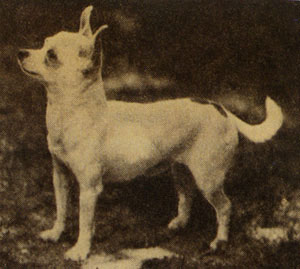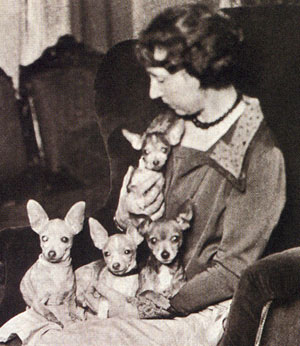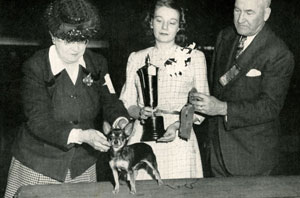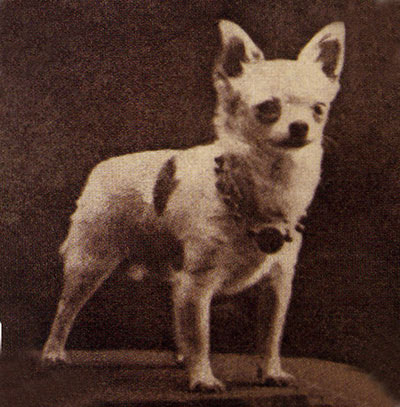- WELCOME
- HOME
- ABOUT US
- CHAMPIONS
-
VERY IMPORTANT DOG
- Ch. South Fork's Jelly Bean
- Ch. South Fork's The Beat Goes On
- Ch. Yo Te Quiero Di Rio Galeria
- Ch. South Fork' Jazz It Up
- Ch. Tocai Di Rio Galeria
- Ch. South Fork's Contradiction
- Ch. South Fork's Music Man
- Ch. El Nino Di Rio Galeria
- Ch. Xsaraja Di Rio Galeria
- Ch. De Gozette Lotus
- Ch. Eldorado Di Rio Galeria
- Ch. Jaqueline Di Rio Galeria
- Ch. Dacarella's Hellf Angel
- SHOW RESULTS
- PUPPIES
- INFO CHIHUAHUA
- CONTACTS
- TOOLS
 |
The Chihuahua, considered the smallest breed in the world, sees its origins attributed to Northern Mexico. We can just formulate hypotheses and conjectures, as there are no reliable evidence; over the decades folk legends have been added, stories totally lacking any scientific foundation, like the one that wants the breed as a result of an hybridization between a dog and a rodent!!!
One of the most accredited versions is that Chihuahuas descend from the Techichi, a dog that used to live with the Toltec populations. This dog is described as small in size, with strong bone and with a long and reddish coat. The existence of this dog seems to have historic evidence given by stone bas-reliefs present in the Franciscan Monastery of Huejotzingo: this convent was built with material taken from the Cholula pyramid. It is likely that this animal also lived with the following civilization, namely that of the Aztecs. According to evidence of Aztec rituals, it seems that a small yellow dog took part in the funeral ceremonies of this ancient civilization. Representations of dogs with similar features can also be found in a near region, the Yucatan, where the Maya/Toltec civilization was located, among the remains of the ancient Chicén Itzà pyramids. |
| Illustrazione dal Codice Magliabecchiano |
Since its beginning, Chihuahuas have been mistaken with the Mexican hairless dog: actually, in the early Twenties in books and articles about the breed we could find three different varieties being described: smooth coat, long coat and...hairless. Hence, even stories regarding this breed were attributed to Chihuahuas, thus creating more confusion. However, most scholars have always maintained that the origins of the Chihuahua are to be found in Europe and China, and that in Mexico there were no dogs before the arrival of the conquistadors. |
 |
| CH La Rex Doll Chicuelo |
|
To support the theory of the European origin of the breed, we have a Botticelli's fresco inside the Sistine Chapel, finished in 1482 (hence ten years before the discovery of America) called "The trials of Moses", where we can actually see a small dog very similar to what is considered to be the original type of the Chihuahua, even if slightly bigger in size and showing some whippet like elements. |
| Particolare Le Prove di Mosè |
Besides, thanks to the analysis of mitochondrial DNA, today even modern science gives confirmation that Chihuahuas are a breed created comparatively recently. Around 1850 some archaeologists, working close to Casas Grande among the ruins of a palace built by Montezuma, found some representations of dogs very similar to those that at the time Mexican campesinos used to sell to American tourists. |
|
| Mrs Annna Vinyard showing CH La Oro Damisela Top Chihuahua 1946 |
| In 1884, at the Philadelphia Kennel Club we have the first Chihuahua to be shown: Chi-Chigas was entered as "Chihuahua Terrier". In 1888 we have an eyewitness in Mr. James Watson, an expert dog lover and judge of the time, who bought for three dollars in El Paso (Texas) a Chihuahua female from the Mexican campesinos; her name was Manzanita; he describes her as being of terrier type, with a coat similar to that of a beaver both for colour and texture, flesh coloured nose and a curled and rather short tail. Later on, he bought a few more of those dogs, among whom there was Juarez Belle, one of the first Chihuahua champions. It is interesting to note that, although Mr. Watson wrote a couple of articles about Chihuahuas, the first in 1888 in the "American Kennel Register" and the second in 1914 in "Country Life in America", he did not metion the breed in his two volumes monumental work "The Dog Book", written in 1916. Probably that's due to the fact that Chihuahuas were not considered a true pure breed yet, as they were very mixed in type. |
At that time, these small dogs were also known as Arizona Dogs, Texas Dogs, Mexican Dogs, because it was in those areas at the borders with Mexico, Arizona and Texas that this peculiar trade took place. Watson describes them as being of different types and indicates a small hole located on top of the skull as the only requirement of purity. During 1890 less than ten Chihuahuas had been shown in a special class for breeds not officially recognized. Midget was the first Chihuahua to be registered with the AKC back in 1904; he was bred and owned by Mr. H. Rayner. Since the beginning of their "official" history, Chihuahuas came in two varieties: smooth coat and long coat, even if the latter were actually rarer. |
 |
| Clara L. Dobbs 1928 with brood bitch of Meron strain |
|
In one of her writings, Ida H. Garrett tells of a visit to the Stewart's estate where the small Caranza lived. She describes him as fabulous specimen of the breed of about 1.4 kg in weight with a dark red long coat, ruby red eyes, tail like that of a squirrel and fringed ears. His body was slightly longer than his height at the shoulder and he had a perfect head; she adds that he was the most beautiful and adorable creature she had ever seen. She also describes this old house belonging to the Stewarts: ovens were built in the walls and inside these ovens they kept Chihuahua bitches with their puppies; also, these ovens were kept at the right temperature thanks to the fire burning in the fireplace. The public interest, at least in the early years, went to the smooth coated variety. In 1905 we have the first Chihuahua champion: it was a female whose name was Beppie and belonging to L.A. Mc Lean. Her title was registered with the AKC in 1908. The Chihuahua Club of America was founden in February 1923 by a small number of pioneers of the breed; the drafting of the standard was a difficult one due to different opinions on what the ideal tail should be like! In 1924 the American Kennel Club officially recognized the breed. In 1926 the AKC was the first club to recognize both varieties and offering prize money at the Sesqui-Centennial Int. Dog Show. In 1928 Don Gringo was the first Chihuahua to become international champion. In June 1952 the Board of the American Kennel Club agreed to separate the two coat varieties so that they could be judged separately. This gave new impulse to the popularity of the long coated variety. Until the present day, in the United States the breed has been getting more and more popular. |
| Ch Beppie |
We can consider the United Kingdom as the second homeland of the breed. In 1902 Chaco was the first Chihuahua to be shown at Richmond; in 1907 we have the first two registrations with Topsy and Prince. Mrs. Powel of London was the true pioneer of the breed. Unfortunately, her dogs were killed in a bombing during the Second World War. We have to wait the end of the war to see new imports into England from the United States; the first import to be registered was a bitch puppy named Una of Phoenix. Again in 1949 the British Chihuahua Club was founded. Since the war, Chihuahuas became popular all over the world. In Italy, pioneers of the breed were Count Giovanni and Countess Licia Lanza di Mazzarino who, since the end of the Fifties, imported the first Chihuahuas and started to breed them with the "di Brusuglio" kennel name. In 1950 we have 5 Chihuahuas registered with the Italian Kennel Club (ENCI); that same year three imports became Italian champions. We have two Chihuahuas registered in 1956 and two more in 1957. Eight Chihuahuas were registered in 1962, 17 in 1963, 8 in 1964, 23 in 1965 and 12 in 1966. In 1991 we have 155 smooth coated Chihuahuas registered and 48 long coated ones; in 1996 260 smooth coats and 90 long coats. Since the half of the 1990s in Italy we see an ever growing popularity of the breed. Registrations with the ENCI see 364 smooth coated Chihuahuas and 190 long coated ones in 2000, 726 in 2002, 770 in 2003, 989 in 2004, 1107 in 2005, 1177 in 2006, 1418 in 2007, 1388 in 2008, 2000 in 2009 and 2644 in 2010! In Italy the breed is protected by the breed club, Club Cani Compagnia, a society which si recognized by the Italian Kennel Club (ENCI) since 1963. |
Bibliography:
|
diriogaleria@chihuahua.it | musicvelvet@chihuahua.it
Words and images ©2011 Di Rio Galeria & Music Velvet Kennels - All rights reserved | Web site by TwentyfourCatsandDogs ©



